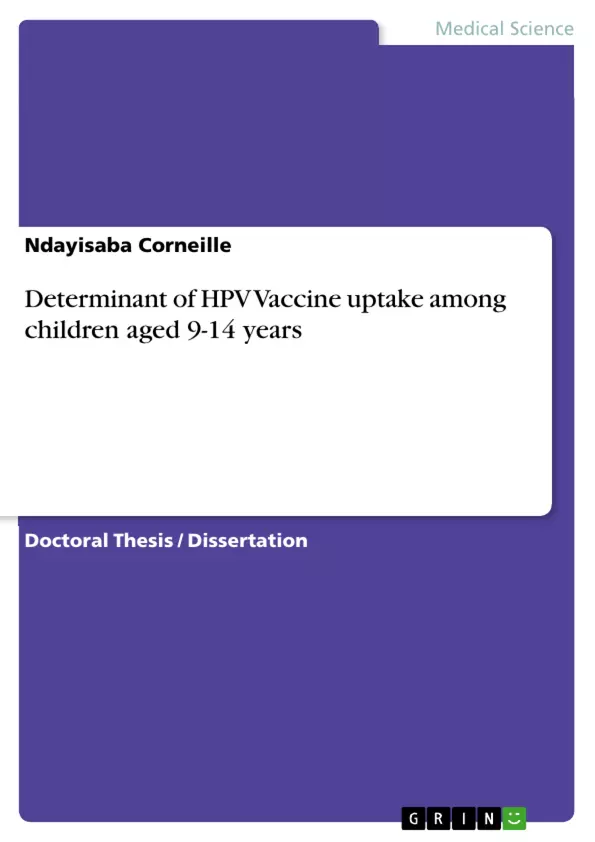This study seekts to determine the factors associate with uptake of human papilloma virus vaccine in Bukomansimbi Sub-County, Bukomansimbi district.
The ministry of health Uganda adopted WHO guideline on routine immunization which was included in UNEPI and ensures that all girls at the age 11-15 to receive full dose in order to have full protection how ever since the introduction of the HPV vaccine in November 2015. There has been low uptake of the vaccine in Uganda with 33,6% prevalence among women combined with low screening uptake , this lead country being one of the highest cervical cancer with incidence rate of 47,5 per 100,000 per year.
At Bukomansimbi Sub County the target population of girl to be vaccinated according to the Bukomansimbi medical center records was 200 girls in the age bracket, many girls do not complete their doses as shown by the vaccination records book, girls normally hide a way during the time of vaccination and parents discourage their girls from receiving the HPV vaccine due to ignorance.
Since infection by HPV is the leading predisposing factor and cause of cancers of the cervix, vagina, and vulva in women this leads to the high expenditures for the family to spend on medical expenses, government on the other hand loses too much to treat.
Inhaltsverzeichnis (Table of Contents)
- Definition of terms
- List of abbreviations
- List of tables
- List of figures
- CHAPTER ONE
- 1.1 Background of the study
- 1.2 Problem statement
- 1.3 Study objectives
- 1.3.1 General objective
- 1.3.2 Specific Objectives
- 1.4 Research questions
- 1.5 Conceptual frame
- 1.6 Significance of the study
- 1.7 Scope of the study
- 1.7.1 Geographical Scope
- 1.7.2 Time Scope
- Chapter Two
- Literature Review
- 2.1 Introduction
- 2.2 Level of uptake of human papilloma vaccine
- 2.3 The caregiver's factors
- 2.4 Health system factors and uptake of HPV vaccine
- Chapter Three
- Methodology
- 3.1 Introduction
- 3.2 Study design
- 3.3 Study area
- 3.4 Sources of data
- 3.5 Study Population
- 3.6 Inclusion criteria
- 3.7 Exclusion criteria
- 3.8 Sampling method
- 3.7.1 Sample size estimation
- 3.8.1 Study variables
- Dependent variable
- The independent variables
- 3.9 Data Collection method
- 3.10 Data collection tools
- 3.11 Data management
- 3.12 Data analysis plan
- 3.13 Ethical considerations
- 3.14 Dissemination of Results
- Chapter Four
- Results
- Chapter Five
- Discussion
- Chapter Six
- Conclusions And Recommendations
- References
- APPENDIX I: CONSENT FORM
- APPENDIX II: QUESTIONNAIRE
Zielsetzung und Themenschwerpunkte (Objectives and Key Themes)
This project aims to assess factors influencing the uptake of the Human Papilloma Virus (HPV) vaccine among girls aged 9-14 in Bukomansimbi Sub County, Bukomansimbi District. The study seeks to understand the level of uptake of the HPV vaccine, identify key factors influencing this uptake, and develop recommendations for improving the vaccination program.
- Factors affecting the uptake of HPV vaccination
- The influence of caregivers' perspectives and knowledge on HPV vaccination
- The role of healthcare systems and accessibility in promoting HPV vaccination
- The impact of socio-cultural beliefs and attitudes on HPV vaccination
- Strategies for improving the uptake of HPV vaccination in the study area
Zusammenfassung der Kapitel (Chapter Summaries)
The initial chapters of the study provide context and background information. The introduction lays out the importance of HPV vaccination and the prevalence of cervical cancer in Uganda. The problem statement identifies the low uptake of the HPV vaccine, and the objectives focus on understanding the underlying reasons.
Chapter Two delves into the relevant literature, examining existing research on HPV vaccination globally and in Uganda. It explores factors influencing vaccine uptake including caregivers' perspectives, healthcare system factors, and socio-cultural influences.
Chapter Three outlines the research methodology. The study employs a mixed-methods approach, utilizing a combination of quantitative and qualitative data collection techniques. This includes a survey of girls aged 9-14 and their caregivers, as well as interviews with healthcare providers and community leaders.
Chapter Four presents the findings of the study, highlighting the key factors identified through data analysis. It examines the relationship between these factors and the level of HPV vaccine uptake in the study area.
Chapter Five focuses on the discussion of the results. It interprets the findings in light of existing literature and provides insights into the complex interplay of factors influencing vaccine uptake.
Schlüsselwörter (Keywords)
This study focuses on the uptake of the HPV vaccine, exploring factors such as caregivers' perspectives, healthcare system accessibility, socio-cultural influences, and the prevalence of cervical cancer. The project also highlights the importance of community engagement and the development of targeted interventions to increase vaccine uptake and promote cervical cancer prevention.
- Arbeit zitieren
- Dr Ndayisaba Corneille (Autor:in), 2020, Determinant of HPV Vaccine uptake among children aged 9-14 years, München, GRIN Verlag, https://www.grin.com/document/1296593



